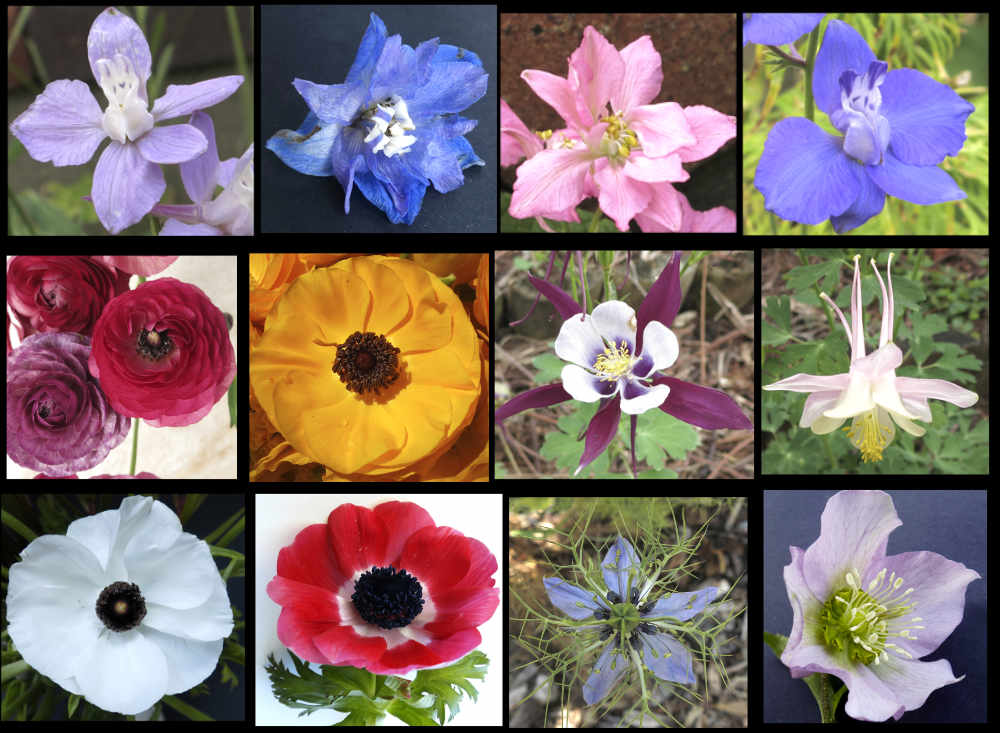Ranunculaceae – Buttercup family.
One of the more primitive families with all the flower parts, indefinite in number, being separate.
The perianth consists of tepals either all similar or differentiated into petal-like and sepal-like.
Also the stamens and carpels are spirally inserted on an enlarged receptacle.
The number of genera ranges from 35 to 70 and species between 1500 and 3,000.
Australia has 5 genera with 39 species and 5 introduced genera.
Adonis, Aquilegia, Clematis, Consolida and Ficaria are naturalised in some places.
Ranunculus and Delphinium together have almost 1000 species.
The family is divided into subfamilies and tribes but there are varying classifications.
Plants are annual or perennial, mostly terrestrial but some are aquatic.
Mostly herbs, there are some lianas and a few small shrubs.
Some have rhizomes and others develop tubers on the roots.
The variable leaves may be in a basal rosette and/or on the stems.
They are mostly alternate in a spiral but are occasionally whorled or opposite.
Leaves can be simple and either entire or dissected to various degrees.
When compound they can be palmate or pinnate with one, two or many divisions.
Leaf edges can be smooth or have blunt or pointed teeth.
When stipules are present they are often conspicuous.
Inflorescences are often a solitary terminal flower but can be a cluster or axillary.
Flowers are mostly bisexual, usually radially symmetric or sometimes bilaterally symmetric.
Most are on stalks and most have no bracts.
The perianth is typically in 2 series with the up to 50 parts in spirals or occasionally whorls.
The parts may be undifferentiated tepals (all sepal-like or all petal-like) or distinct sepals and petals.
In some the tepals gradually merge from sepal-like to petal-like.
The perianth can be flattish, some have nectar spurs and others have hoods.
Where there is a distinct calyx there are (3) 5 to 8 (many) sepals that often become petal-like.
Where there is a distinct corolla it can have (0) 3 to 50 petals that possibly arise from the stamens.
They may have nectaries at their bases.
Colours include yellow, red, blue, green and purple plus white.
There are usually (5) 10 to 100 free stamens in a spiral or rarely whorls.
The anthers are mostly basifixed and open outwards or sideways via longitudinal slits or valves.
Anthers rarely have appendages.
There are usually 5 to 8 (1, 3 – many) carpels, usually free and in a spiral.
They are superior and on a slightly elongated receptacle.
The number of locules varies and each can have from 1 to 100 ovules.
The carpels usually have hooked tips from the styles which persist into the fruit.
The fruit are mostly aggregates of the fruit from each of the carpels.
The individual segments are often a follicle or achene.
The achenes can have a feathery appendage derived from the style.
The fruit are rarely fleshy berries and in Nigella they are capsules.
(An achene is a dry indehiscent fruit from a carpel with a single locule with one ovule/seed.
A follicle, from a carpel with one locule, is dry and dehisces down one side.)
J.F.


